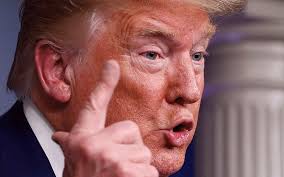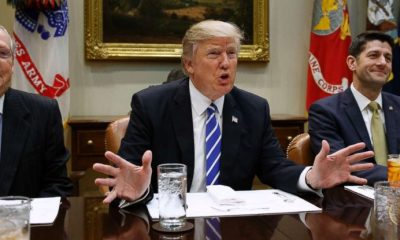World
White House defends new Air Force One deal after Trump’s attack on expense
Washington: The White House defended the deal of new Air Force One aircrafts with Boeing company, after President-elect Donald Trump called for cancelling the order claiming the new aircraft too expensive in a Twitter post earlier on Tuesday.
“I think the American people would expect that future presidents would benefit from unique and upgraded capabilities while flying aboard Air Force One,” White House press secretary Josh Earnest told reporters on board the presidential plane flying to Tampa, Florida.
However, it’s up to the Trump administration to determine whether the project will be completed, said Earnest.
“The updated Air Force One is not set to come online until 2023,” he said. “This is a longer-range plan, but ultimately the planning work that we have done on behalf of future presidents is something the next administration will have to decide to carry forward.” he said.
“Boeing is building a brand new 747 Air Force One for future presidents, but costs are out of control, more than $4 billion. Cancel order!” Trump tweeted.
“We want Boeing to make a lot of money, but not that much money,” he then told reporters in a briefing. However, the $4-billion price tag Trump claimed for the cost of the new aircraft could not be immediately confirmed.
Earnest said some of the data Trump referenced to “don’t appear to reflect the nature of the financial agreement between Boeing and the Department of Defence.”
The upgrades to the new plane, which include security enhancements, are being made per the recommendation of national security experts, he added.
Also on Tuesday, Boeing said in a statement that the company is “currently under contract for $170 million to help determine the capabilities of these complex military aircraft that serve the unique requirements of the President of the United States.”
The two 747-200 aircrafts currently used as Air Force One has been in flight since the Reagon era in 1980s. Though the two planes have been heavily modified, they are due to reach the end of their planned 30-year life in 2017.
In January, Boeing secured a contract from the Pentagon to start development work on the 747-8 jumbo jets that would replace the aging planes, according to a Wall Street Journal report.
Boeing was the US government’s second biggest federal contractor last year behind Lockheed Martin Corp., according to federal procurement data.
World
Lockdowns in China Force Urban Communities to Defy Censorship and Vent Frustration Online

Shanghai’s rich middle class is leading a wave of online dissent over the strict and prolonged lockdowns imposed in various parts of the country. Chinese internet censorship is struggling as patience is wearing thin in many urban centers, coming up with creative forms of online protests.
Social Media Posts Revealing Lockdown Tension in Shanghai
Drawn-out lockdowns are nothing new in China as authorities insist with the nation’s zero-Covid policy since the start of the pandemic. Currently over This time around, however, metropolitan areas like Shanghai are increasingly difficult to keep quiet, given that its more than 25 million residents have seen weeks of total isolation along with food shortages and many other service interruptions.
Dozens of towns and reportedly over 300 million Chinese citizens have been affected by lockdowns of different severity. As expected, urban netizens have been most outspoken over their difficulties by finding creative ways to get around state censorship and bans placed on topics, news comments and spontaneous campaigns.
Shanghai residents have been using mobile proxies and hijacking seemingly unrelated hashtags to talk about healthcare issues, delivery failures and the overall severity of their situation. The “positive energy” that the Chinese government wants to transmit during the recent prolonged series of lockdowns does not come naturally to those counting food supplies and online censors are working hard to filter words, trending topics and undesired social media sharing.
WeChat groups and message threads are under constant monitoring. Posts questioning the zero-Covid approach have been quickly deleted, including by leading Chinese health experts like Dr. Zhong Nanshan. Video footage is soon censored and protests and investigations are quickly made to disappear.
Where this has not worked, officials have exposed banners with warnings and outright threats like “watch your own mouth or face punishment”, while drones have been patrolling the city skies. Yet, if anything, this has led to further tensions and unspoken confrontation with Shanghai’s educated and affluent middle class.
Creative Online Solutions Harnessing Civic Energy
Announcements by Chinese social media that they would be publishing the IP addresses of users who “spread rumors” have not helped either. Tech industry research has shown that much of Asia’s tech-savvy population has a habit of using mobile proxies and other privacy tools, quickly finding workarounds to browse the internet freely and talk to the world about the hottest topics.
The sheer volume of forbidden posts is already a challenge for the very censorship system, experts explain. Unable to track all trending hashtags, state workers overlook topics that speak about the US, Ukraine or other popular news. Linking human rights elsewhere to their situation, Chinese online dissidents establish their informal channels and “hijack” the conversation to share personal or publicly relevant information about the Covid suppression in their town.
Sarcastic and satirical posts still dominate. Others hope to evade the censors by replacing words from famous poems or the national anthem. One thing is certain – social media, when harnessed with the right creativity, has proven its ability to mount pressure on the government in even some of the most strictly controlled tech environments like China.
























